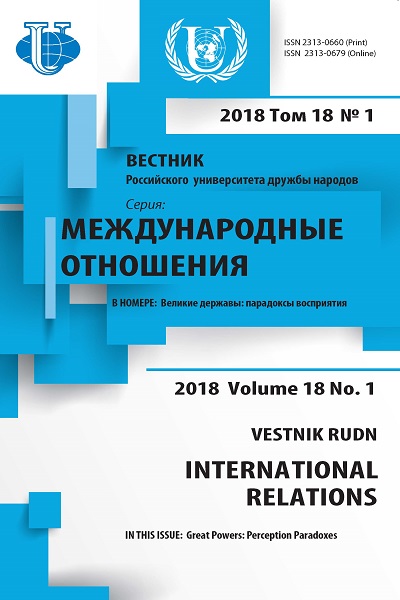Factor of external authority for small states and integration in the Post-Soviet space
- 作者: Rtskhiladze G.V.1
-
隶属关系:
- Tbilisi Open University
- 期: 卷 18, 编号 1 (2018): Great Powers: Perception Paradoxes
- 页面: 33-48
- 栏目: THEMATIC DOSSIER
- URL: https://journals.rudn.ru/international-relations/article/view/18375
- DOI: https://doi.org/10.22363/2313-0660-2018-18-1-33-48
如何引用文章
全文:
详细
The search for foreign policy guidelines for the newly independent states that emerged as a result of the collapse of the USSR, is closely linked to the recognition on their part of certain norms, values and attitudes as benchmarks in the international arena. In addition, the foreign policy orientation of a state that has gained independence implies its strategic orientation to individual states or a union of states that are its authority. This article considers the main cause-effect manifestations of this factor with reference to “transitional” post-Soviet states in the context of Russia’s integration initiatives. The article states the fact that Russia is striving to implement integration projects in the post-Soviet space, but there are barriers on this path that are caused by Russia’s objective (primarily economic) relative weakness in comparison with the cumulative West. However, there is another, very strong reason for the problematic integration under Russia’s leadership-the lack of a value system and ideological attraction in post-communist Russia, unlike the West, which has long understood itself as a single value system. This factor, in turn, hinders the strengthening of Russia’s image, which, despite its strong political and economic leverage, does not become a foreign policy authority for other post-Soviet states. Consequently, integration and cooperation within the structures dominated by Russia (CIS, CSTO, EAEC) has significant flaws, the spirit of partnership is often dominated by the rivalry and self-interest of individual state actors that perceive national interests in their own way; there is no ideological basis for cohesion and solidarity between these states-actors. Russia lacks not only pronounced positive value points that are attractive to its neighbors, but it also can’t justify the existence of a common external enemy or common challenges. Without this factor, the strength of alliances under the leadership of Russia becomes more problematic.
作者简介
Gulbaat Rtskhiladze
Tbilisi Open University
编辑信件的主要联系方式.
Email: politforumi@gmail.com
PhD in Political Sciences, Senior Researcher of the Tbilisi Open University, Founder of the NGO “Institute of Eurasia”
参考
- Angelow, J. (2000). Kalkül und Prestige. Der Zweibund am Vorabend des Ersten Weltkrieges. Köln: Habil.-Schrift. Böhlau Verlag.
- Deutsch, K. W. (1968). Die Analyse internationaler Beziehungen, Konzeptionen und Probleme der Friedensforschung. Frankfurt am Mein: Europaische Verlagsanstalt.
- Duchhardt, H. (2000). Grundmuster der internationalen Beziehungen in der Frühen und Späten Neuzeit. In: Strukturwandel Internationaler Beziehungen. Zum Verhältnis von Staat und internationalem System seit dem Westfälischen Frieden. Ed. by J. Siegelberg, K. Schlichte. Wiesbaden: VS Verlag für Sozialwissenschaften, p. 74—85.
- Heinze, Е. (2009). Einführung in die Welt-System Analyse von Immanuel Wallerstein. Bremen, 2009. URL: https://neuesoziologie.files.wordpress.com/2011/01/einfc3bchrung-in-die-welt-system-analyse-von-immanuel-wallerstein.pdf (accessed: 13.06.17).
- Herz, J. J. (1974). Staatenwelt und Weltpolitik. Aufsätze zur Internationalen Politik im Nuklearzeitalter. Hamburg: Hoffmann und Campe.
- Hütter, J. (1976). Einführung in die internationale Politik. Stuttgart: Kohlhammer.
- Kissinger, H. (1997). Diplomacy. Moscow, Ladomir. (Russian Edit.).
- Krippendorf, E. (1973). Ist Aussenpolitik Aussenpolitik? In: Internationale Bezeigungen. Köln-Gütersloh: Kiepenheuer & Witsch, p. 189—213.
- Kurylev, K. (2014). Foreign policy of Ukraine in the context of the formation of a regional security system in Europe. Moscow, RUDN University. (In Russ.).
- Krell, G. (2000). Weltbilder und Weltordnung — Einführung in die Theorie der Internationalen Beziehungen. Baden-Baden: Nomos.
- Lake, D. (2004). Hierarchy in International Relations: Authority, Sovereignty, and the New Structure of World Politics. University of California, San Diego. URL: https://pdfs.semanticscholar.org/ 5a9e/eb441ba5b9ac2d1de5674064b488eff4772d.pdf (accessed: 13.06.17).
- Meinecke, F. (1929). Die Idee der Staatsräson in der neueren Geschichte. München/Berlin: Oldenbourg.
- Nohlen, D. (2003). Lexikon der Politik. Bd. 2. Berlin: Beck.
- Prittwitz, V. (1994). Politikanalyse. Opladen: VS Verlag für Sozialwissenschaften, 1994.
- Schmitt, C. (1963). Der Begriff des Politischen. Berlin: Duncker & Humbold.
- Seifert, A.-Cl. (1996). Konflikte und Werte-Pluralität in unserer Welt. In: Dokumentation zum Zweiten Strausberger Symposium, p. 243—250.
- Simonis, G. & Elbers, H. (2003). Studium und Arbeitstechniken der Politikwissenschaft. Opladen: VS Verlag für Sozialwissenschaften.
- Wallerstein, I. (1986). Das moderne Weltsystem I — kapitalistische Landwirtschaft und die Entstehung der europäischen Weltwirtschaft im 16. Jahrhundert. Frankfurt am Main: Promedia.
- Wolf, R. (2001). Partnerschaft oder Rivalität? Sicherheitsbeziehungen zwischen Siegermächten im Lichte von Theorien internationaler Politik. Baden-Baden: Nomos-Verl.-Ges.
- Woyke, W. (Hrsg.). (2000). Handwörterbuch Internationale Politik. Opladen: VS Verlag für Sozialwissenschaften.








